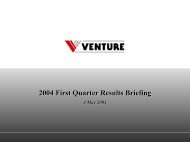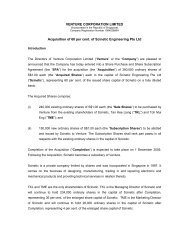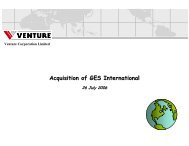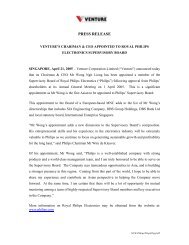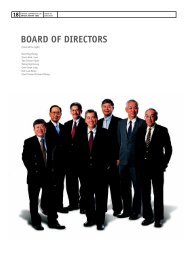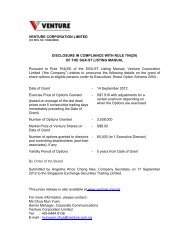Annual Report 2006 - Venture Corporation Limited
Annual Report 2006 - Venture Corporation Limited
Annual Report 2006 - Venture Corporation Limited
You also want an ePaper? Increase the reach of your titles
YUMPU automatically turns print PDFs into web optimized ePapers that Google loves.
notes to financial statements<br />
December 31, <strong>2006</strong><br />
2 SUMMARY OF SIGNIFICANT ACCOUNTING POLICIES (Cont’d)<br />
q) BORROWING COSTS – Borrowing costs are recognised in the profit and loss statement in the period which they<br />
are incurred. No interest expense has been capitalised during the year.<br />
r) RETIREMENT BENEFIT COSTS - Payments to defined contribution retirement benefit plans are charged as an<br />
expense as they fall due. Payments made to state-managed retirement benefit schemes, such as the Singapore<br />
Central Provident Fund, are dealt with as payments to defined contribution plans where the group’s obligations<br />
under the plans are equivalent to those arising in a defined contribution retirement benefit plan.<br />
s) EMPLOYEE LEAVE ENTITLEMENT – Employee entitlements to annual leave are recognised when they accrue to<br />
employees. A provision is made for the estimated liability for annual leave as a result of services rendered by<br />
employees up to the balance sheet date.<br />
t) INCOME TAX - Income tax expense represents the sum of the tax currently payable and deferred tax.<br />
The tax currently payable is based on taxable profit for the year. Taxable profit differs from profit as reported in<br />
the profit and loss statement because it excludes items of income or expense that are taxable or deductible in<br />
other years and it further excludes items that are not taxable or tax deductible. The group’s liability for current tax<br />
is calculated using tax rates (and tax laws) that have been enacted or substantively enacted in countries where<br />
the companies and subsidiaries operate by the balance sheet date.<br />
Deferred tax is recognised on differences between the carrying amounts of assets and liabilities in the financial<br />
statements and the corresponding tax bases used in the computation of taxable profit, and is accounted for<br />
using the balance sheet liability method. Deferred tax liabilities are generally recognised for all taxable temporary<br />
differences and deferred tax assets are recognised to the extent that it is probable that taxable profits will be<br />
available against which deductible temporary differences can be utilised. Such assets and liabilities are not<br />
recognised if the temporary difference arises from goodwill or from the initial recognition (other than in a<br />
business combination) of other assets and liabilities in a transaction that affects neither the taxable profit nor the<br />
accounting profit.<br />
Deferred tax liabilities are recognised for taxable temporary differences arising on investments in subsidiaries and<br />
associates, and interests in joint ventures, except where the group is able to control the reversal of the temporary<br />
difference and it is probable that the temporary difference will not reverse in the foreseeable future.<br />
The carrying amount of deferred tax assets is reviewed at each balance sheet date and reduced to the extent<br />
that it is no longer probable that sufficient taxable profits will be available to allow all or part of the asset to be<br />
recovered.<br />
Deferred tax is calculated at the tax rates that are expected to apply in the period when the liability is settled or<br />
the asset realised based on the tax rates (and tax laws) that have been enacted or substantively enacted by the<br />
balance sheet date. Deferred tax is charged or credited to profit or loss, except when it relates to items charged<br />
or credited directly to equity, in which case the deferred tax is also dealt with in equity.<br />
Deferred tax assets and liabilities are offset when there is a legally enforceable right to set off current tax assets<br />
against current tax liabilities and when they relate to income taxes levied by the same taxation authority and the<br />
group intends to settle its current tax assets and liabilities on a net basis.<br />
Current and deferred tax are recognised as an expense or income in profit or loss, except when they relate to<br />
items credited or debited directly to equity, in which case the tax is also recognised directly in equity, or where<br />
they arise from the initial accounting for a business combination. In the case of a business combination, the tax<br />
effect is taken into account in calculating goodwill or determining the excess of the acquirer’s interest in the net<br />
fair value of the acquiree’s identifiable assets, liabilities and contingent liabilities over cost.<br />
50 venture corporation limited



